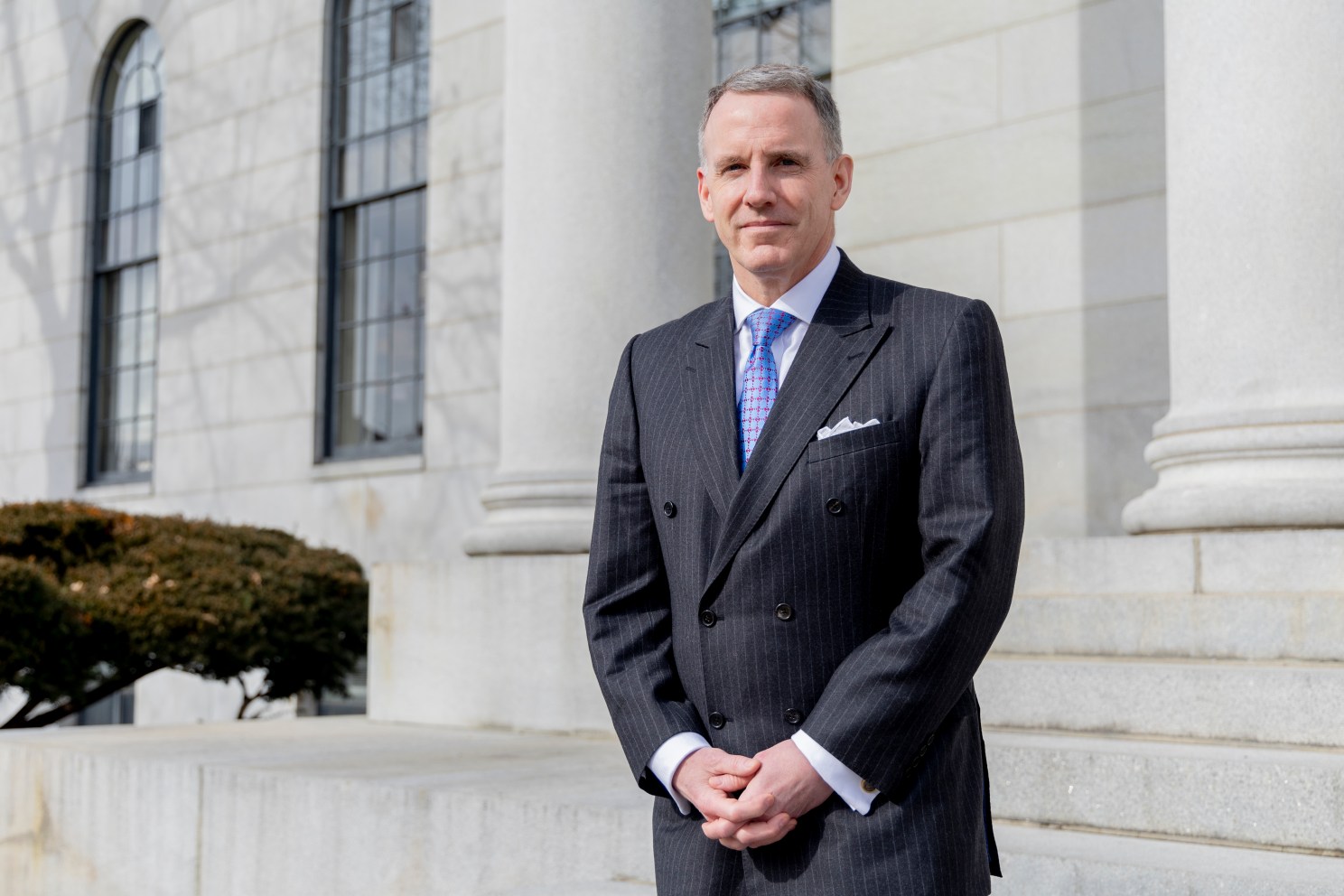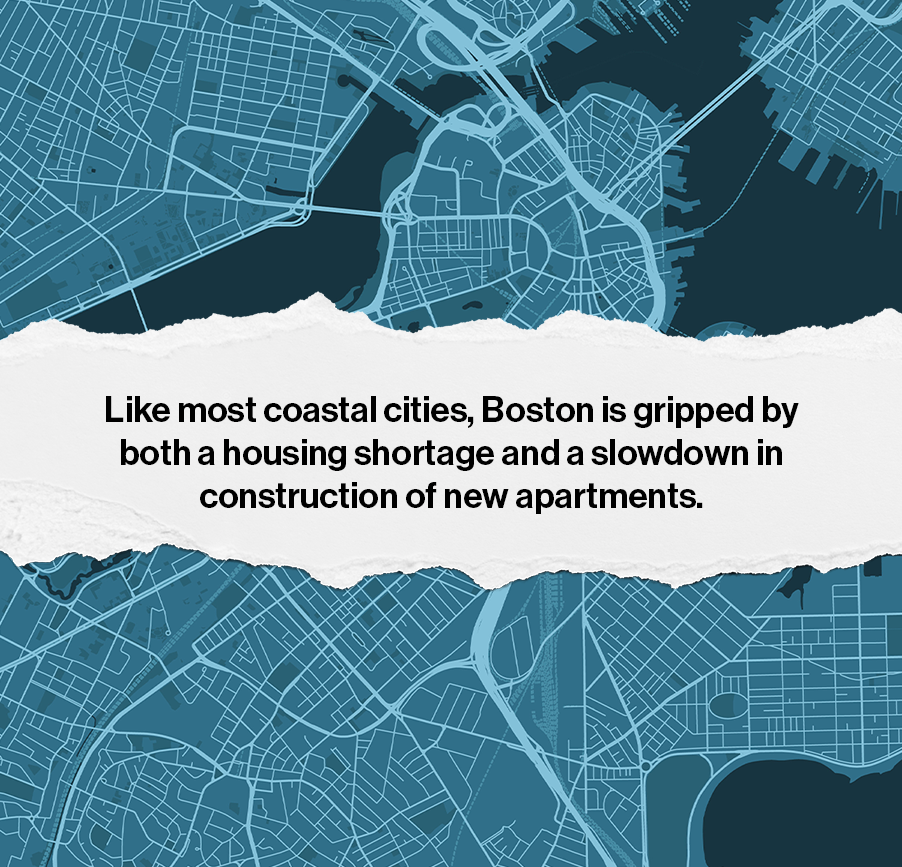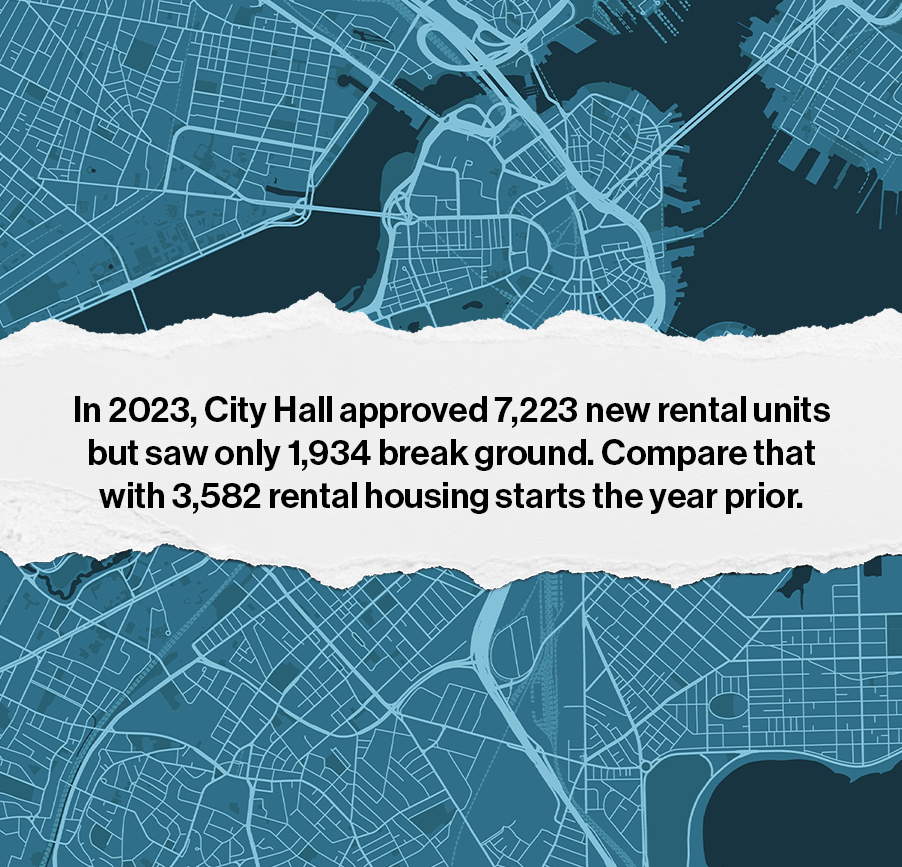
Edward Glaeser, the Fred and Eleanor Glimp Professor of Economics and chair of the Department of Economics, poses for a portrait outside the Littauer Center of Public Administration at Harvard University. Photo by Dylan Goodman
Photo by Dylan Goodman
Lending a hand to a former student — Boston’s mayor
Economist gathers group of Boston area academics to assess costs of creating tax incentives for developers to ease housing crunch
A group of real estate developers pitched Boston Mayor Michelle Wu ’07, J.D. ’12, early last year on the creation of incentives for building more housing in a time of high labor costs and interest rates.
Like most coastal cities, Boston is gripped by both a housing shortage and a slowdown in construction of new apartments. In 2023, City Hall approved 7,223 new rental units but saw only 1,934 break ground. Compare that with 3,582 rental housing starts the year prior.

Illustrations by Liz Zonarich/Harvard Staff

Property-tax reductions, the developers argued, would kickstart projects. Wu indicated interest in the idea. “But first she wanted to see some real academic analysis,” recalled Edward Glaeser, the Fred and Eleanor Glimp Professor of Economics and chair of the Department of Economics.
Wu reached out to her former professor, who offered to study the proposal with a group of Boston-area academics. All six donated their services to the endeavor, which resulted in a 47-page report. Ultimately, Wu opted against the abatements.
The Gazette caught up with Glaeser, author of 2011’s “Triumph of the City,” to learn more about the report’s findings and his other ideas for addressing the housing crisis. The interview was edited for length and clarity.
How did Mayor Wu enlist your help with studying tax abatements?
This report really started in the fall of 2004 when I taught the math-track intermediate microeconomics class to Mayor Wu. The fact that she took such a hard course and did so well speaks to the horsepower she brings.
I’m told Mayor Wu mentioned my name to one of the developers as a person whose analysis she would value. That developer reached out last spring and asked if I would do it. I said I would be happy to, but the request would need to come from Mayor Wu directly. I was willing to work for the mayor and only the mayor.
So, the mayor called my cell. I said that I really wanted my terrific “Economics of Cities” co-teacher, Denise DiPasquale,to be my partner and that we would form a committee. I said I would need the cooperation of the Boston Planning & Development Agency (BPDA). And then I made a bunch of wildly overoptimistic predictions about how quickly we could get this thing done.
Let’s talk about the report itself. What approach did you take to your subject?
There are two things to think about with any subsidy program. First, what’s the benefit of getting more of the thing the city is subsidizing? Second, how much is this effectively costing the city of Boston? I thought we should not be in the business of opining on the first topic. Determining the benefit of building more housing is a political question and a job for elected officials. Consequently, there’s nothing in the report which says the city should do X or Y.
We focused on how much each created unit costs the city under different policies. But we didn’t simply look at the tax subsidy per unit. A lot of the units that get any subsidy would have been built anyway. We calculated the difference in the number of units built with and without the subsidy.
We were also very focused on what’s called tax expenditures. You might think giving 5,000 new units no property taxes for the next 15 years is no big deal since they’re all new — the tax subsidy is not going to reduce total tax revenues.
But those 5,000 units require city services. If the units are built, those costs are imposed on the city. A better approach is: Take as your starting point the situation where everyone pays regular taxes — and then calculate the difference in tax revenues relative to that.
How does your report account for the impact of interest rates?
Part of the reason construction has stalled is that interest rates have spiked, but interest rates might not stay high. Committee members Paul S. Willen [an economist with the Boston Federal Reserve Bank] and Adam Guren [an economics professor at Boston University] both worked with two interest rate predictions — one higher, one lower.
Low interest rates don’t necessarily make the tax cost per unit higher or lower. But more projects are permitted when interest rates are low. We see the tax abatement policy having a larger impact when interest rates are low, but we also see more inframarginal units — meaning units get the tax benefit but were going to be built anyway.
On the other hand, the policy doesn’t have much impact when interest rates are high. But incentives don’t go to units that were going to be built anyway.
How much would a tax reduction policy cost the city? And how much housing would it get in return?
In our lower interest rate scenario, Willen’s analysis shows 3,017 units being produced without any policy change whatsoever. The most generous tax abatement policy, with no property taxes ever, gets the city to 4,800 units, which means the policy gets about 1,800 more units. That costs Boston about $500,000 per unit in terms of tax expenditure. It’s a pretty expensive policy. We found it hard by Willen’s methodology to get the cost below $230,000 per unit.
Guren makes it look cheaper in part because he predicts smaller base levels of real estate production. His lowest cost was $170,000 per unit, but the city would only get 71 extra units in that scenario. If Boston wanted more units, it could offer $5,000 in tax abatements per year over 15 years. That would cost $200,000 per unit with higher interest rates and $217,000 with lower rates. That isn’t far off from the Willen numbers, and we feel comfortable in this middle ground.
It’s no surprise the mayor took a pass. As an expert on cities who has taught urban economics for more than 25 years, what else do you think governments can do to build more affordable units?
For every brownfield site, I would have high density as of right [meaning developers would not need to seek zoning variances]. I would also make it easier to tear down things like triple deckers and replace them with higher-density buildings.
It’s harder to know what to do on the cost side. The problem is, if the zoning process takes an enormous amount of time and involves an enormous amount of risk, it’s hard for developers to bear those costs unless they’re producing high-end products with high markups.
It’s important not to think of housing as Boston’s problem alone. It’s part of a region. Population density in Middlesex County, where Harvard sits, is considerably lower than in Harris County, Texas, which includes Houston. And Harris County is building a heck of a lot more housing.
I’m a big fan of Massachusetts 40B [passed in 1969 to help affordable housing developments skirt local zoning restrictions]. I’m happy to think about 40B on steroids and say, “If you’re really low-density, and you don’t allow any building, we’re going to make it easy for people to come in and build whatever they want.”
Some people believe it’s crucial that every high-end Boston suburb build lots of affordable housing. But I’m OK with richer suburbs not building as long they help pay for building elsewhere.
I would propose giving areas building quotas. Those not in compliance will need to pay in. If we make the quotas proportional to price and current land density, they would be very high for places like Lincoln and Weston. These places probably won’t meet their quotas, which means that they will have to pay. Meanwhile, a place like Revere will probably meet its quota and get a little money at the expense of Weston and Lincoln. Obviously, the rules would need to exclude places with prices below a certain level. No part of this should penalize lower-income communities.




